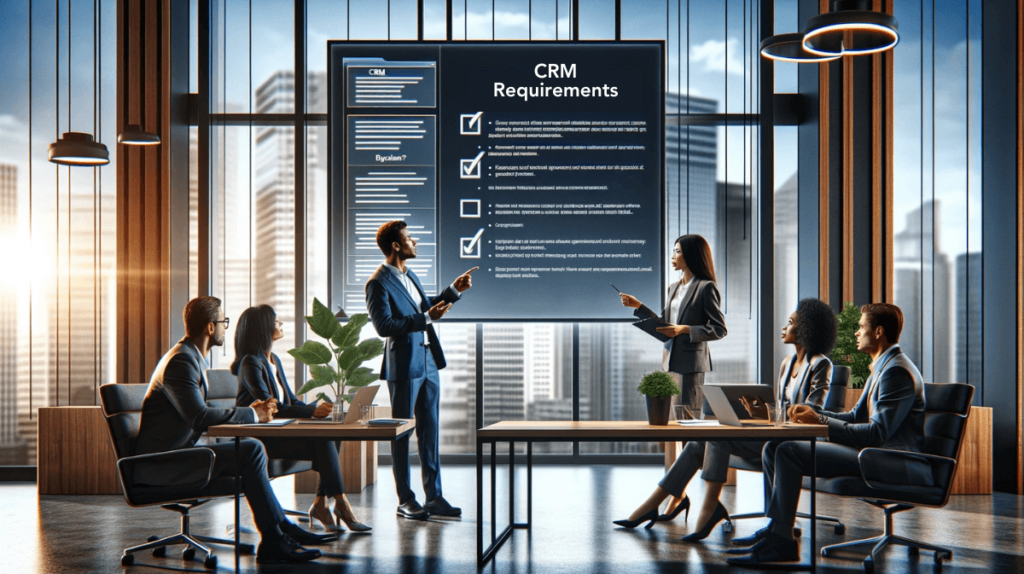Starting a CRM (customer relationship management) requirements document from a blank slate is complicated.
While every business is different, the following set of example CRM requirements, based on a fictional kiosk manufacturer, provides a framework for the information that can be given to a would-be CRM implementation company.

A document like this is essential because it will give your prospective CRM service providers a substantial amount of the information they need to estimate the scope of required CRM services more precisely.
They may want to pose additional questions before providing an estimate for services.
This approach goes beyond a traditional RFP, which is usually too general and is often more a checklist of features than a set of requirements.
To get to the point of starting your requirements document, we recommend first gathering and prioritizing business requirements as part of a structured CRM selection process.
Beginning with foundational goals and setting realistic expectations will make your selected CRM solution more successful.
Business Overview & Current State
Abbott Ltd. has been in business since 2005. We sell kiosks directly to commercial and government accounts in the United States and Canada. We have a distributor in Europe and a distributor in Asia.
In the commercial arena, customers include retail chains, independent retailers, and hotel chains. Kiosks are installed in retail stores, hotel lobbies, airports, and other places. We currently have over 300 customers, with an average of 25 locations per customer. Many locations have more than one kiosk.
Our addressable market is over 10,000 companies.

Sales
We have ten outside account executives (AEs), most working from home offices. There is one AE for each of the nine U.S. census regions and one AE for Canada. Three inside sales development representatives (SDRs) support the AEs. SDRs are not currently paired with AEs. Any SDR can work with any AE.
There are two regional sales managers (RSMs) the AEs report to. One RSM is responsible for the east plus Canada. The other RSM is responsible for the west. The RSMs report to the VP of Sales.
Two sales engineers (SEs) also align with the two regions. SEs accompany AEs on sales calls when needed.
One major account representative works on a dozen or so large accounts. This person reports directly to the VP of Sales.
Salespeople currently use contact managers, spreadsheets, and email address books to manage their contacts. The adoption of our current contact manager by field users is low.
Some AEs have PC notebooks, and some have Macbooks. Some AEs use iPhones, and some use Android devices. Half of our AEs use a tablet computer.

Our AEs are responsible for managing existing accounts, developing net new business independently, and following up on leads handed off to them by SDRs.
AEs identify critical players within target organizations, assess requirements, and ultimately create proposals. Our proposals are 8 – 12 page documents with embedded pricing spreadsheets. Our quoting process is complex, as kiosks need to be engineered for specific customer requirements.
The account may be split up among multiple AEs in companies with many divisions across different territories.
Marketing
We have a marketing manager who reports to the VP of Marketing. About half our leads come from four different landing pages on our website, 20% from trade shows, 20% from webinars, and 10% from referrals/word of mouth.
We have a contract blogger who writes informational posts relevant to anyone who purchases or manages kiosks. Our CEO is a thought leader in the kiosk industry and periodically writes blog posts.
Calls to action at the bottom of posts drive visitors to landing pages where visitors can download additional informational content in exchange for information such as their name, company name, email address, and phone number.
New website leads are currently emailed to all three SDRs. SDRs enter the lead information into our contact manager and follow up via phone and email. We currently have five different email templates that our SDRs can choose from when communicating with leads.
We use Twitter, Facebook, LinkedIn, and SlideShare to drive people interested in kiosk information to our blog.
We use Zoom to run our webinars. Invitees and attendees are managed outside of our contact management system.
Other types of leads, such as trade show leads, are manually imported into our contact management system. SDRs select from new leads, assign themselves as the manager of the leads, and make calls.
When an SDR qualifies a lead, based on five qualification criteria and their general sense of its viability, they email the AE responsible for the corresponding region. AEs periodically email SDRs with updates on leads handed off to them.
We currently send a monthly newsletter to selected contacts at customer accounts. This is being done outside of our contact manager.
Customer Support
We currently have three inside customer support representatives (CSRs) who report to a customer service manager. We have direct, online access to 90% of the kiosks in the field and can remotely diagnose and resolve about 75% of issues.

Kiosk issues are reported in various ways:
- Automated emails from the kiosk with diagnostic information
- Emails from a customer contact
- A filled-in form on our website
- Phone calls from a customer contact (usually from someone at the kiosk location)
Support issues are currently logged into a shared Microsoft Access database. Our customers are encouraged to include the serial number of the kiosk in question whenever they report an issue. If they do not provide the serial number on submission of the issue, a CSR will always request the number.
Emails and form submissions currently go to all three CSRs. An available CSR takes ownership of the issue to try and resolve the issue via remote access to the kiosk. If a software issue can’t be solved, the CSR will forward the email to one of our engineers or call an engineer.
If it is determined that a part needs to be replaced, the part will be shipped to the customer site. Customers can replace some parts. Other parts can only be replaced by a field service representative (FSR). We have contract FSRs whom CSRs can dispatch.
We have a homegrown knowledge base that our IT department maintains. Customers are encouraged to check the knowledge base before submitting a support case. Our CSRs will sometimes email links to specific knowledge base articles to more technically savvy customer contacts as part of the issue resolution process.
Systems
We currently use Microsoft Office 365 for our email. Our PC users are using Outlook 2016 on the desktop, but we have a variety of email clients across the organization, including:
- Outlook Web
- Mac Mail
- iPhone Email Client
- iPad Email Client
- Android Email Client
We have a legacy, in-house ERP system that runs on SQL Server. Our IT department manages our ERP system. Our IT team can create daily CSV exports. They also have the tools to write ERP data to a web services endpoint.
Project Success Factors
Based on our experience with under-utilized systems, the following are some of the success factors we’ve identified for our current CRM initiative:
- End-user input into the design process
- Third-party recommended best practices
- An initial focus on the highest-value functionality
- A comprehensive view of customer information from a single interface
- Easy access to essential information from multiple platforms (PC, Mac, iPad, iPhone, Android)
- Internal ownership and support of the application after the initial rollout
- An ongoing training strategy
Sales, Marketing, and Support Processes
Lead Generation and Lead Management
We have four different landing pages on our website. One example is https://offers.abbott-ltd.demo/how-to-spec-out-a-kiosk.
We want to directly capture leads from this form and three other forms into a CRM system. New leads should be distributed to our SDRs in a round-robin fashion.
To support our business model, the SDRs should be able to view and maintain the following information for leads.
- Lead Source (website, tradeshow, webinar)
- Landing page name (for leads that came from our website)
- Lead Status (New, Working, Qualified, Disqualified, Customer)
- Reason Disqualified (Too Small, Unserved Geography, Bad Information, Competitor)
- Number of locations
- Currently using kiosks? (Y/N)
- Current kiosk vendor(s) (link to competitor company records)
- Personal LinkedIn profile URL
- Role (IT, Executive Management, Marketing)
- Rating (A, B, C) The rating will be calculated based on various data points in the lead
If a lead’s company already exists in the database, the SDR should be able to add that person to the existing company record.
When an SDR qualifies a lead, the SDR should convert the lead to an account/contact and assign the account to the appropriate AE. The AE should receive an email notification that the account has been handed off to them.
SDRs should not create sales opportunities.
AEs should only create opportunities after discussions with one or more key contacts at the customer or prospect account.
Customer and Prospect Management
To support our business model, we need to track both office locations and locations where kiosks are installed in a parent/child relationship.
We need to track the following information at the company level.
- Customer Accounting ID
- Type (Prospect, Customer, Vendor, Competitor)
- Customer Sub-Type (Business Office, Kiosk Location)
- Status (Active/Inactive)
- Number of locations (in parent company record only)
Customer Related Information – Sales Order History
For our AEs to easily see recent sales orders, they should see a list of sales order header information for the last two years when looking at an account. AEs do not need to see sales order details, but they should, at minimum, see the following information for each sales order:
- Salesperson
- Territory
- Sales Order Number
- P.O. Number
- Order Date
- Ship Date
- Total Dollar Amount
When looking at a customer account record, our AEs and other CRM users should also be able to see the following financial information for the customer.
- MTD Sales
- YTD Sales
- Previous YTD Sales
- Credit Limit
- Amount Past Due
Our IT team can schedule a daily CSV export of new sales orders from our legacy, in-house ERP system. They can also schedule a daily CSV export of customer financial data. These files can be posted to an FTP site.
Location Related Information – Kiosks
We need to track the kiosks that are installed at each location. Our IT department can provide an export file of kiosks at each location with the following data points:
- Serial number
- Model
- Operating System
- Software Version
- Date Installed
- Warranty Expiration Date
Initially, we will manually enter or import new locations and kiosks into CRM.
Customer and Location-Related Information – Support Cases
Our AEs, SEs, and major account representatives should have visibility to any open support issues when viewing a customer record.
Contact Management
There is information about contacts that we want to track, and that may not be in the standard CRM configuration:
- Role (picklist – map values from leads on lead conversion)
- Email 2 (many contacts in our contact manager have more than one email address)
- Holiday Card (checkbox)
- Status (Active/Inactive)
- Personal LinkedIn profile URL
While viewing a contact record, our users should be able to see the account’s Status and Type without navigating to the account record.
Opportunity Management and Forecasting
AEs should create opportunities in CRM for:
- Potential add-on sales to existing accounts
- Potential new sales to new accounts
We need to track the following:
- Type (add-on or net new business)
- SDR (if the opportunity originated as a lead so the SDR can be credited with a sale)
- Expected close date
- Expected revenue
- Stage (we have a five-stage sales process)
- Commit (Yes/No)
- Competitors (there could be zero, one, or several competitors on a deal)
- Reason Lost (there are five general reasons that we lose deals)
Marketing
The existing web forms on our four existing landing pages should be replaced with new web forms, which, upon visitor submission, will automatically create new lead records in the CRM system.
We want to send our monthly customer newsletter directly from the CRM system, allowing users to view opens, clicks, and unsubscribes. We are not committed to any particular email marketing solution.
While we have had success with GoToMeeting, we are interested in a webinar platform that integrates with CRM so that we can accomplish the following:
- Have webinar registrants be automatically added into CRM as new leads (also – update leads or contacts if they already exist, rather than creating duplicates)
- View which live webinars each lead or contact attended
- View which recorded webinars each lead or contact viewed
- View engagement for each of the above (what percentage of the webinar they viewed)
We will evaluate marketing automation systems later this year and want to ensure that the systems we look at will integrate with the chosen CRM system. The leading candidates are HubSpot and ActiveCampaign.
Customer Support
We want to manage our support cases within the CRM system.
Emails that go to support@abbott-ltd.demo should automatically create new cases in the system. When a case is created, our three CSRs should all be notified of the new case. All email communication with the customer contact who submitted the case should be managed within the case.
We want to replace the form on https://offers.abbott-ltd.demo/support with a form that, when submitted, creates a new case in the CRM system.
If a high-priority case is not resolved within 24 hours, the customer service manager should receive an email.
The following is the information that we would like to track within the case:
- Type (Hardware, Software)
- Priority (High, Medium)
- Location (link to location/account record)
- Serial Number (link to kiosk record)
- Customer Contact (link to contact record)
Reports & Dashboards
The main goal for the use of reporting and dashboards is so that management can ensure:
- We are consistently feeding the top of the funnel with new leads
- New leads are being worked on in a timely fashion by the SDRs
- Lead conversion continues to grow over time
- Management has visibility to new sales opportunities
- Management knows what the highest-value opportunities are
- Customer service issues are being handled expediently
- User adoption can be monitored, and under-adoption can be addressed
The following is the initial set of reports that we have identified:
Lead Reports
- Number of new leads created QTD, by month (bar chart)
- Current status of all leads – Open, Working, Qualified, Disqualified (bar chart)
- Leads created this month by lead source MTD (pie chart)
- Lead conversion rate this month vs. last month
Opportunity Reports
- Top five open opportunities closing this quarter (text)
- Opportunities by stage, closing this quarter, grouped by month (stacked bar chart)
- Opportunities by lead source, closing this quarter (pie chart)
- The dollar amount of opportunities expected to close this quarter, grouped by salesperson (bar chart)
- Number of lost opportunities, YTD, grouped by lost reason (bar chart)
- Average time to close deals (previous four quarters)
Case Management Reports
- Currently open cases by stage
- Cases solved MTD and QTD by Type
- Average resolution time (this quarter and the previous two quarters)
Adoption Reports
- Recent logins by user
- New Accounts created YTD, by month (line chart)
- New activities created YTD, by month
Email Integration
We currently use Microsoft 365, but only some users use Outlook 365 on their desktops.
At a minimum, our users need to be able to attach sent and received emails — from whichever email client they happen to be using — to lead and contact records in CRM.
When an AE emails a proposal, we want the AE to attach the proposal to the contact record for the primary contact and attach the proposal to the Opportunity record if possible.
An AI email writing assistant would be a plus — but this is a want rather than a need.
Users should optionally be able to synchronize their CRM calendar to their Outlook calendar.
Smartphone Access
Our AEs and SEs use a combination of iPhones and Android devices. The most critical required functionality for smartphones is:
- iPhone and Android device compatibility
- Search for contacts to access phone numbers and email addresses
- Log detailed meeting notes after on-site meetings
- Attach SMS text exchanges to contact records
- Search for accounts and review recent calls, meetings, and email activity
- View MTD and YTD sales totals for customers
- View any open support cases
Data Migration
We only need to migrate the critical information in our contact management system. We plan to keep the contact management system active and accessible for as long as necessary in case users need to refer back to information that was not migrated.
Contact Information:
- Record ID
- Company Name
- Contact Name
- Title
- Role
- Phone Number + Extension Number
- Mobile Number
- Email Address (our current system allows for multiple email addresses per contact)
- Street, City, State, ZIP
- Status
- Annual Revenue
- Last Result (only for reference. We do not need this field moving forward)
Related Information:
- Email History – going back to January 1, 2018
- Notes – going back to January 1, 2018
We do not need to migrate:
- Secondary Contacts
- Cases
- Opportunities
- File Attachments
Each of a customer’s multiple locations is in our ERP system as separate Ship To addresses. We plan to extract a CSV of all customer locations, and we would like these to be added as separate account records in the CRM system, all with a relationship to the parent record.
Record and Field Permissions
The following are the general permissions needed:
- Customer Accounting ID should be read/only to all users except administrators
- SDRs should have read/only access to opportunity fields
- Each AE should only see accounts that are in their territory
- RSMs should only see accounts that belong to their AEs
- AE’s should be able to share specific accounts manually
- Case and Kiosk fields should be read-only for all sales users
Internal Systems Support
We are looking for an implementation partner for our Phase I implementation. As part of the commitment to a new CRM system, we plan to have our current contact manager administrator and another person trained in CRM system administration.
We also want at least one of our in-house developers to attend a developer training session for the selected CRM system.
Subsequent Phase Requirements
The following are some of the areas we would like to target in subsequent phases after the initial rollout:
Additional ERP Integration
Automated updates of Ship To locations and kiosk information from the ERP to the CRM system.
Automated Case Creation from Kiosks
Our kiosks can send alerts with multiple diagnostic data points. Eventually, we would like these data points to be written directly to fields within support cases to prioritize and route support cases when they are created intelligently.
We want to learn about AI-enabled case routing.
Knowledge Base
While our current knowledge base is working, we would like to ultimately have the knowledge base be a part of the CRM system.
AI Chatbot
We want to deploy an AI chatbot to help deflect specific requests and would like platform recommendations for this functionality.

